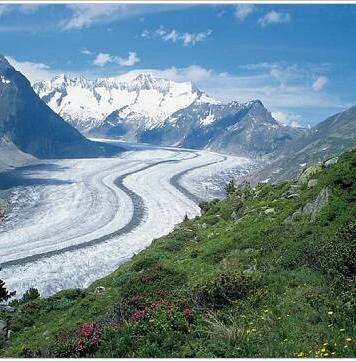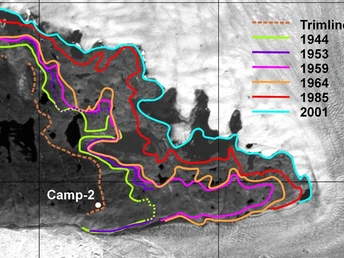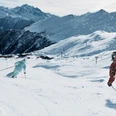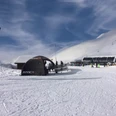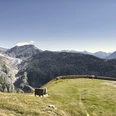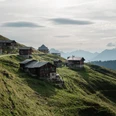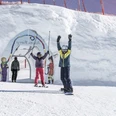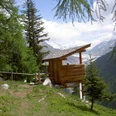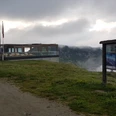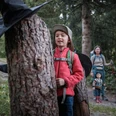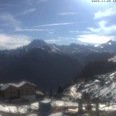- Photos & Map
How would you like to arrive?
- Description
- Good to know
- Nearby
- 0:31 h
- 1.86 km
- 40 m
- 3 m
- 2,095 m
- 2,133 m
- 38 m
- Start: Belalp, mountain station cable car
- Destination: Hotel Belalp - Aletschbord
Embark on a special kind of time travel. The glacier nature trail on Belalp leads you from the cable car mountain station to Aletschbord. The installation starts with an explanation of the path and ends with a look into the future.
The Past: 1892 - An era that made all of Europe freeze and posed great challenges to the agrarian society. At that time, the mighty glaciers of the Alps, which extend far into the valleys, were interpreted as a great threat.
The Time Travel: Time markers indicate the years in which the Great Aletsch Glacier reacted extremely - as a long-term response to the changing climate. In these years, the glacier tongue melted back by more than 40 m, the size of the Statue of Liberty.
The Present: Upon reaching Aletschbord, you get a view of the current state of our contemporary witness and a glance back at how it once was.
Good to know
Pavements
Best to visit
Directions
On the path from the mountain station of the Belalp cable car to the Aletschbord, a glacier nature trail is installed, which on one hand points to the dramatic effects of climate change and on the other hand is part of the tourist offer of the Blatten-Belalp destination. In addition, it is directly connected to the interactive exhibition at the World Nature Forum of the UNESCO World Heritage Swiss Alps Jungfrau-Aletsch. Initiators of the project are Dr. Sebastian König, the Kulturbärg association, and the visitor center of the UNESCO World Heritage Swiss Alps Jungfrau-Aletsch.
Tour information
Cultural Interesting
Stop at an Inn
Equipment
Sturdy footwear, weather-appropriate clothing, sun and rain protection, as well as sufficient supplies of food and drinks, are recommended in case no hospitality or shopping facilities are available or open. Although the path is very well marked throughout, for safety reasons you should always carry a suitable hiking map. Bring poles or other aids.
Directions & Parking facilities
Arrival by car
From Western Switzerland: A9 Lausanne - Vevey, or Northwestern Switzerland: A12 Bern - Vevey: A9 - Sierre: main road Sierre - Brig
From Northwestern Switzerland: A6 Bern - Thun - Spiez: main road Spiez - Kandersteg (car shuttle Lötschberg tunnel) - Goppenstein - Gampel - Brig
From Eastern and Central Switzerland: Andermatt - Realp (year-round car shuttle Furka; in summer via Furka pass) - Oberwald - Brig
From Ticino (in summer): Airolo - Nufenen Pass - Ulrichen – Brig
Or via Centovalli – Domodossola – Simplon Pass – Brig
From Italy (Aosta, Mt. Blanc Tunnel): Aosta - Grand Saint Bernard Tunnel (in summer via the pass) - Martigny: Autobahn A9 - Sierre: main road Sierre – Brig
Or via Domodossola – Simplon Pass – Brig
Blatten near Naters
From Brig you reach Blatten near Naters via Naters, then take the cable car to the car-free Belalp.
Paid parking spaces are available at Chienzlichrommu and in the parking garage in Blatten near Naters.
More information can be found at:
You can reach Blatten near Naters by public transport or by private vehicle from Brig or Naters. Then take the cable car to Belalp. Timetable at www.belalp.ch
Additional information
If you have questions, please contact:
Belalp Bahnen AG
Blatten - Belalp Tourismus AG
Author´s Tip / Recommendation of the author
Learn more about the Aletsch Glacier, climate change, and the mountain world of the UNESCO World Heritage Swiss Alps Jungfrau-Aletsch in the interactive exhibition at the World Nature Forum in Naters.
Safety guidelines
Despite the "non-deviating" marking of the hiking trails, we recommend always carrying a corresponding hiking map for safety reasons, so that for example in a thunderstorm or emergency you can quickly find a safe area.
Especially in autumn, note that fallen leaves on the ground can hide unevenness, roots, stones, or holes in the path. After storms, trees may still fall or branches drop afterwards. Particularly in adverse weather conditions, muddy and slippery sections can occur on natural paths. You must expect such trail impairments when hiking.
Not all rocks or cliffs are secured with ropes or railings. Surefootedness is partially required. If you believe certain trail sections are impassable for you, you should bypass them.
Nearby
